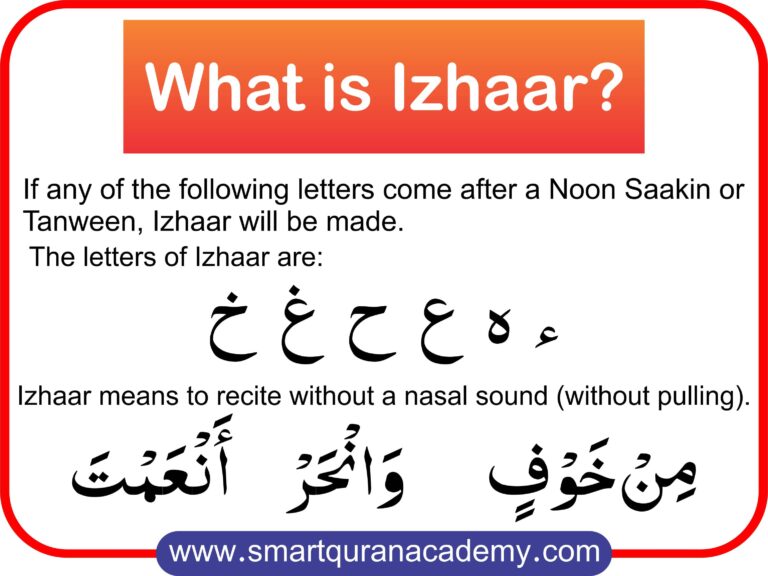Izhar Letters In Arabic

Izhar is an Arabic word that means manifestation, and it is one of the Tajweed principles. In Tajweed, the word “Izhar” refers to pronouncing a letter straight through, without pause, quiet, stress, or Ghunna.
What Are The Conditions Of Izhar?
There are several conditions of Izhar that you need to know. They include Noon Sakinah (static Noon) or Tanween (Nunation) with one of the Izhar letters following it, either in the same word or the next. Therefore, both the Noon or Tanween and the Izhar letter are pronounced clearly in this context.
Watch Video for More Details About Izhar Letters
What Are The Izhar Letters?
Well, there is a total of 6 Izhar letters in Arabic that you need to know. These letters include Alif, Khaa’, Ain, H, Ghin, and Haa’.
Some of the examples of Izhar are as follows:
- The letter “a” is followed by the letter “n,” which is the letter for Noon, in the word Anamat. Thus, it is easy to pronounce the letters Noon and Ain.
- Alimn-Khaber, where the letter “n” is a Tanween and is followed by the letter “Kh,” which starts the next word with the Khaa’ letter. Thus, the letters Tanween and Khaa’ are articulated clearly.
- Tanhtoon is read with the “n” sound representing the letter Noon and the “h” sound representing the letter Haa’.
- In this instance, Jorfn-Har, the Tanween letter “n” is followed by the letter “H” at the start of the subsequent word. Therefore, it is also easy to pronounce the Tanween and H.
- ILahn-Ghirh is read with a Tanween “n” and a Ghin letter (“Gh”) after it. As a result, the letters Tanween and Ghin are articulated clearly.
- As you can see, the first letter of the following word, Klon-Aamn, is an Alif, and the second letter, “n,” is a Tanween. As a result, it is easy to pronounce the Tanween and the Alif.
What Are The Types Of Izhar?
When it comes to the types of Izhar letters in Quran then there are only three types. Each Izhar type is completely different from the other one.
We are mention these Izhar types as follows:
- Oral Izhar – It is associated with Meem Sakinah and occurs when any letter of the alphabet—aside from Baa’ and Meem letters—is pronounced. This Meem is pronounced clearly without Ikhfa or Idgham because it follows Meem sakinah.
- Ultimate Izhar – The Noon Sakinah (static Noon) Izhar is known as the ultimate Izhar. This Izhar is then followed by a “Waw” or “Yaa” letter, which are Idgham letters, in the same word. Because it cannot be articulated through the throat or lips, it is known as the ultimate Izhar. Senwan, Qenwan, Bonyan, and Al-Donya are the only four words in the Quran that describe the Ultimate Izhar. As you can see, each of these words begins with the Noon Sakinah and ends with either the Yaa’ or the Waw letter.
- Pharyngeal Izhar – The most common Izhar is named pharyngeal because all the Izhar letters (Alif, H, Ain, Ghin, Haa’, and Khaa’) are uttered from the throat or pharynx. It occurs when the Noon Sakinah or Tanween is followed by one of the Izhar letters.
What Are The Ranks Of Izhar?
There are total three ranks of Izhar. The top one occurs with the letters H and Alif while the middle one is with the letters Ain as well as Haa’. On the other hand, the lower one with the letters Ghin and Kha’.
Izhar is applied due to the distance between the Noon letter’s exit or Tanween and the Izhar letter’s exit. Thus, we do not have to use ikhfaa or idgham at this point. All we have to do is to pronounce every letter clearly and properly. It is imperative to pronounce the Izhar letter, Noon sakinah, or tanween clearly.
So, here we defined it well according to over knowledge if you have any suggestions or queries want to know about Quran you can contact smart Quran academy and also check our about Tajweed rules and much more about online Quran classes.

 +1 (380)206-9388
+1 (380)206-9388
